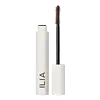Ilia Limitless Lash Lengthening Clean Mascara Versus Tower 28 Beauty MakeWaves Lengthening + Volumizing Mascara
What's inside
What's inside
 Key Ingredients
Key Ingredients

 Benefits
Benefits

 Concerns
Concerns

 Ingredients Side-by-side
Ingredients Side-by-side

Water
Skin ConditioningCera Alba
EmollientButyrospermum Parkii Butter
Skin ConditioningPolyglyceryl-6 Distearate
EmulsifyingDimer Dilinoleyl Dimer Dilinoleate
EmollientGlycerin
HumectantCopernicia Cerifera Cera
EmollientPolyglyceryl-10 Myristate
Skin ConditioningCetyl Alcohol
EmollientGlyceryl Caprylate
EmollientLeuconostoc/Radish Root Ferment Filtrate
AntimicrobialZea Mays Starch
AbsorbentXanthan Gum
EmulsifyingArginine
MaskingPhenethyl Alcohol
MaskingBiotin
AntiseborrhoeicUrtica Dioica Extract
Astringent1,2-Hexanediol
Skin ConditioningCaprylyl Glycol
EmollientSodium Benzoate
MaskingCitric Acid
BufferingPotassium Sorbate
PreservativeBenzoic Acid
MaskingMyristoyl Pentapeptide-17
Skin ConditioningCI 77499
Cosmetic ColorantCI 77491
Cosmetic ColorantCI 77492
Cosmetic ColorantCI 77891
Cosmetic ColorantWater, Cera Alba, Butyrospermum Parkii Butter, Polyglyceryl-6 Distearate, Dimer Dilinoleyl Dimer Dilinoleate, Glycerin, Copernicia Cerifera Cera, Polyglyceryl-10 Myristate, Cetyl Alcohol, Glyceryl Caprylate, Leuconostoc/Radish Root Ferment Filtrate, Zea Mays Starch, Xanthan Gum, Arginine, Phenethyl Alcohol, Biotin, Urtica Dioica Extract, 1,2-Hexanediol, Caprylyl Glycol, Sodium Benzoate, Citric Acid, Potassium Sorbate, Benzoic Acid, Myristoyl Pentapeptide-17, CI 77499, CI 77491, CI 77492, CI 77891
Water
Skin ConditioningCopernicia Cerifera Wax
Glyceryl Stearate
EmollientHydrogenated Olive Oil Stearyl Esters
Emulsion StabilisingSynthetic Wax
AbrasiveVp/Va Copolymer
Stearic Acid
CleansingHelianthus Annuus Seed Wax
Skin ConditioningPalmitic Acid
EmollientButylene Glycol
HumectantOlea Europaea Oil Unsaponifiables
Skin ConditioningAminomethyl Propanol
BufferingRicinus Communis Seed Oil
Masking1,2-Hexanediol
Skin ConditioningCaprylyl Glycol
EmollientPolyimide-1
Galactoarabinan
Rhus Succedanea Fruit Wax
Shorea Robusta Resin
TonicSodium Dehydroacetate
PreservativeLecithin
EmollientTocopherol
AntioxidantAscorbyl Palmitate
AntioxidantCitric Acid
BufferingCI 77499
Cosmetic ColorantCI 77007
Cosmetic ColorantWater, Copernicia Cerifera Wax, Glyceryl Stearate, Hydrogenated Olive Oil Stearyl Esters, Synthetic Wax, Vp/Va Copolymer, Stearic Acid, Helianthus Annuus Seed Wax, Palmitic Acid, Butylene Glycol, Olea Europaea Oil Unsaponifiables, Aminomethyl Propanol, Ricinus Communis Seed Oil, 1,2-Hexanediol, Caprylyl Glycol, Polyimide-1, Galactoarabinan, Rhus Succedanea Fruit Wax, Shorea Robusta Resin, Sodium Dehydroacetate, Lecithin, Tocopherol, Ascorbyl Palmitate, Citric Acid, CI 77499, CI 77007
 Reviews
Reviews

Ingredients Explained
These ingredients are found in both products.
Ingredients higher up in an ingredient list are typically present in a larger amount.
1,2-Hexanediol is a synthetic liquid and another multi-functional powerhouse.
It is a:
- Humectant, drawing moisture into the skin
- Emollient, helping to soften skin
- Solvent, dispersing and stabilizing formulas
- Preservative booster, enhancing the antimicrobial activity of other preservatives
Caprylyl Glycol is a humectant and emollient, meaning it attracts and preserves moisture.
It is a common ingredient in many products, especially those designed to hydrate skin. The primary benefits are retaining moisture, skin softening, and promoting a healthy skin barrier.
Though Caprylyl Glycol is an alcohol derived from fatty acids, it is not the kind that can dry out skin.
This ingredient is also used as a preservative to extend the life of products. It has slight antimicrobial properties.
Learn more about Caprylyl GlycolCi 77499 is also hydrated iron III oxide. It is created from mixing red and black iron oxides. This helps give shades of darkness to a product.
Iron III oxides are classified as inorganic chemicals for coloring.
Citric Acid is an alpha hydroxy acid (AHA) naturally found in citrus fruits like oranges, lemons, and limes.
Like other AHAs, citric acid can exfoliate skin by breaking down the bonds that hold dead skin cells together. This helps reveal smoother and brighter skin underneath.
However, this exfoliating effect only happens at high concentrations (20%) which can be hard to find in cosmetic products.
Due to this, citric acid is usually included in small amounts as a pH adjuster. This helps keep products slightly more acidic and compatible with skin's natural pH.
In skincare formulas, citric acid can:
While it can provide some skin benefits, research shows lactic acid and glycolic acid are generally more effective and less irritating exfoliants.
Most citric acid used in skincare today is made by fermenting sugars (usually from molasses). This synthetic version is identical to the natural citrus form but easier to stabilize and use in formulations.
Read more about some other popular AHA's here:
Learn more about Citric AcidWater. It's the most common cosmetic ingredient of all. You'll usually see it at the top of ingredient lists, meaning that it makes up the largest part of the product.
So why is it so popular? Water most often acts as a solvent - this means that it helps dissolve other ingredients into the formulation.
You'll also recognize water as that liquid we all need to stay alive. If you see this, drink a glass of water. Stay hydrated!
Learn more about Water